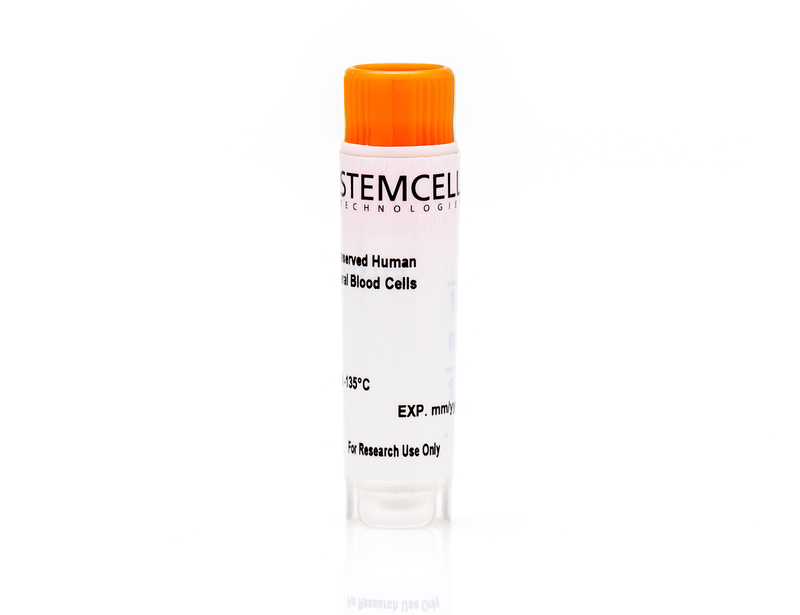Human Peripheral Blood Macrophages, Frozen
Primary human cells, frozen
概要
Primary human macrophages were derived from immunomagnetically selected peripheral blood (PB) monocytes. Monocytes were cultured in RPMI 1640 Medium with 10% fetal bovine serum (FBS), M-CSF and IL-4 for 5 days to generate macrophages. PB was collected using acid-citrate-dextrose solution A (ACDA) as the anticoagulant.
Cells were obtained using Institutional Review Board (IRB)-approved consent forms and protocols.
Certain products are only available in select territories. Please contact your local Sales representative or Product & Scientific Support at techsupport@stemcell.com for further information.
Browse our Frequently Asked Questions (FAQs) on Primary Cells.
Cells were obtained using Institutional Review Board (IRB)-approved consent forms and protocols.
Certain products are only available in select territories. Please contact your local Sales representative or Product & Scientific Support at techsupport@stemcell.com for further information.
Browse our Frequently Asked Questions (FAQs) on Primary Cells.
Contains
• CryoStor® CS10
Subtype
Frozen
Cell Type
Macrophages, Monocytes, Myeloid Cells
Species
Human
Cell and Tissue Source
Peripheral Blood
Donor Status
Normal
Purity
The purity of macrophages is ≥ 90% for MHC class II, CD11b, CD18, and CD68 by flow cytometry.
技术资料
| Document Type | 产品名称 | Catalog # | Lot # | 语言 |
|---|---|---|---|---|
| Product Information Sheet | Human Peripheral Blood Macrophages, Frozen | 70042 | All | English |
数据及文献
Publications (2)
Cell host {\&} microbe 2020
TMEM173 Drives Lethal Coagulation in Sepsis.
Abstract
Abstract
The discovery of TMEM173/STING-dependent innate immunity has recently provided guidance for the prevention and management of inflammatory disorders. Here, we show that myeloid TMEM173 occupies an essential role in regulating coagulation in bacterial infections through a mechanism independent of type I interferon response. Mechanistically, TMEM173 binding to ITPR1 controls calcium release from the endoplasmic reticulum in macrophages and monocytes. The TMEM173-dependent increase in cytosolic calcium drives Gasdermin D (GSDMD) cleavage and activation, which triggers the release of F3, the key initiator of blood coagulation. Genetic or pharmacological inhibition of the TMEM173-GSDMD-F3 pathway blocks systemic coagulation and improves animal survival in three models of sepsis (cecal ligation and puncture or bacteremia with Escherichia coli or Streptococcus pneumoniae infection). The upregulation of the TMEM173 pathway correlates with the severity of disseminated intravascular coagulation and mortality in patients with sepsis. Thus, TMEM173 is a key regulator of blood clotting during lethal bacterial infections.
Molecular therapy : the journal of the American Society of Gene Therapy 2014 MAR
Design of a novel integration-deficient lentivector technology that incorporates genetic and posttranslational elements to target human dendritic cells.
Abstract
Abstract
As sentinels of the immune system, dendritic cells (DCs) play an essential role in regulating cellular immune responses. One of the main challenges of developing DC-targeted therapies includes the delivery of antigen to DCs in order to promote the activation of antigen-specific effector CD8 T cells. With the goal of creating antigen-directed immunotherapeutics that can be safely administered directly to patients, Immune Design has developed a platform of novel integration-deficient lentiviral vectors that target and deliver antigen-encoding nucleic acids to human DCs. This platform, termed ID-VP02, utilizes a novel genetic variant of a Sindbis virus envelope glycoprotein with posttranslational carbohydrate modifications in combination with Vpx, a SIVmac viral accessory protein, to achieve efficient targeting and transduction of human DCs. In addition, ID-VP02 incorporates safety features in its design that include two redundant mechanisms to render ID-VP02 integration-deficient. Here, we describe the characteristics that allow ID-VP02 to specifically transduce human DCs, and the advances that ID-VP02 brings to conventional third-generation lentiviral vector design as well as demonstrate upstream production yields that will enable manufacturing feasibility studies to be conducted.


